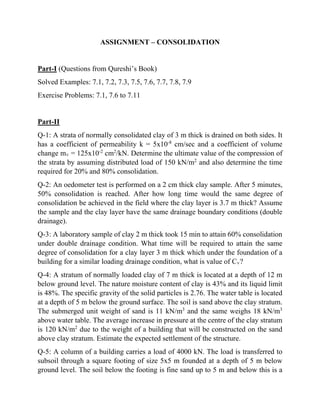
Geotechnical Engineering-I [Lec #22A: Consolidation Problem Sheet]
- 1. ASSIGNMENT – CONSOLIDATION Part-I (Questions from Qureshi’s Book) Solved Examples: 7.1, 7.2, 7.3, 7.5, 7.6, 7.7, 7.8, 7.9 Exercise Problems: 7.1, 7.6 to 7.11 Part-II Q-1: A strata of normally consolidated clay of 3 m thick is drained on both sides. It has a coefficient of permeability k = 5x10-8 cm/sec and a coefficient of volume change mv = 125x10-2 cm2 /kN. Determine the ultimate value of the compression of the strata by assuming distributed load of 150 kN/m2 and also determine the time required for 20% and 80% consolidation. Q-2: An oedometer test is performed on a 2 cm thick clay sample. After 5 minutes, 50% consolidation is reached. After how long time would the same degree of consolidation be achieved in the field where the clay layer is 3.7 m thick? Assume the sample and the clay layer have the same drainage boundary conditions (double drainage). Q-3: A laboratory sample of clay 2 m thick took 15 min to attain 60% consolidation under double drainage condition. What time will be required to attain the same degree of consolidation for a clay layer 3 m thick which under the foundation of a building for a similar loading drainage condition, what is value of Cv? Q-4: A stratum of normally loaded clay of 7 m thick is located at a depth of 12 m below ground level. The nature moisture content of clay is 43% and its liquid limit is 48%. The specific gravity of the solid particles is 2.76. The water table is located at a depth of 5 m below the ground surface. The soil is sand above the clay stratum. The submerged unit weight of sand is 11 kN/m3 and the same weighs 18 kN/m3 above water table. The average increase in pressure at the centre of the clay stratum is 120 kN/m2 due to the weight of a building that will be constructed on the sand above clay stratum. Estimate the expected settlement of the structure. Q-5: A column of a building carries a load of 4000 kN. The load is transferred to subsoil through a square footing of size 5x5 m founded at a depth of 5 m below ground level. The soil below the footing is fine sand up to 5 m and below this is a
- 2. soft compressible clay soil of thickness 5 m. The water table is found at a depth of 2m below the base of the footing. The specific gravities of the solid particles of sand and clay are 2.64 and 2.72 and their natural moisture contents are 25% and 40% respectively. The sand above the water table may be assumed to remain saturated. The plastic limit and plasticity index of clay soils are 30 and 40%, respectively. Estimate the probable settlement of the footing if the average increase in stress at the center of clay layer is 64 times the contact pressure at the footing base. Q-6: Soil investigation at a site gave the following information. Top soil up to a depth of 10.6 m is fine sand, and below this lies soft clay layer of 7.6 m thick. The water table is at 4.6 m below the ground surface. The submerged unit weight of sand is 10.4 kN/m3 , and wet unit weight above water table is 17.6 kN/m3 . The normal water content of the normally consolidated clay is 40%, its liquid limit is 45% and specific gravity of the solid particles is 2.78. The proposed construction will transmit a net stress of 120 kN/m2 . Estimate the average settlement of the clay layer. Q-7: The effective overburden pressure at the middle of a saturated clay layer 4 m thick is 10 T/m2 , and is drained both sides. The overburden pressure at the middle of the clay layer is expected to be increased by 150 kN/m2 due to the load from a building structure at the ground surface. An undisturbed soil sample of clay 20 mm in thickness is tested in a consolidometer. The total change in thickness of the spevimen is 0.8 mm when the applied load is 100 kN/m2 . The final water content of the sample is 24% and the specific gravity of the soli is 2.72. Estimate the probable settlement of the proposed structure. Q-8: Two points on a curve for normally consolidated clay have the following coordinates. Point 1: e1 = 0.7, p1 = 1.0 kg/cm2 Point 2: e2 = 0.6, p2 = 3.0 kg/cm2 If the average overburden pressure on a 6 m thick layer is 1.5 kg/cm2 , how much settlement the clay layer experience due to additional load intensity of 1.6 kg/cm2 . Q-9: A consolidation test is performed on a representative sample taken from a 12 m thick clay layer and following parameters were obtained: Pc = 190 kPa, Cr = 0.022, Cc = 0.262, eo = 0.725
- 3. If the existing overburden pressure at the centre of the clay layer po = 130 kPa and the additional pressure at the centre of the clay layer due to structural load is 220 kPa, compute the total settlement due to the primary consolidation. Q-10: A soil sample has a compression index of 0.3. If the void ratio e at a stress of 1.4 kg/cm2 is 0.5, compute (i) the void ratio if the stress in increased to 2 kg/cm2 , and (ii) the settlement of a soil stratum of 4 m thick.